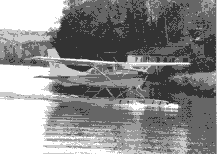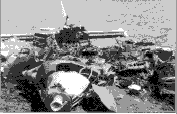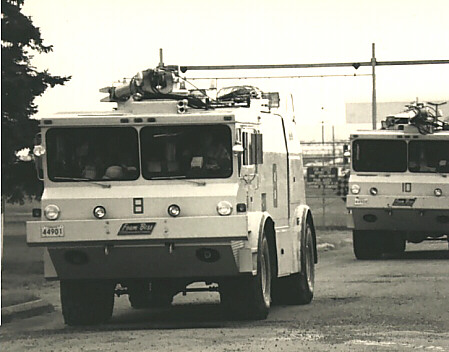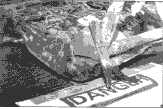On July 20, 1996, Pierre Meloche, President of the Association des pilotes de brousse du Québec (the Quebec bush pilots' association) died in a tragic seaplane accident. He drowned while trying to save his passengers after his Cessna 206 flipped as he was attempting a heavy water takeoff from Rivière des Prairies.
Pierre managed to rescue two of his six passengers, but, sadly, he and four others drowned.
"Learn from the mistakes of others; You'll not live long enough to make them all yourself ..." has long been the banner of Transport Canada, System Safety. The following letter by George C. Velguth was originally published on the Internet and in the November/December 1996 issue of Water Flying. It sets an example we can all follow in learning from others:
The tragic Meloche accident has catalyzed me to stop merely thinking about steps to enhance my ability to egress an inverted floatplane and start implementing them. I was especially moved by the fact that his friend had apparently established his own avenue of escape, then drowned [while] attempting to save the children. Of course, any of us would probably do the same.

File C206 photo
However, in an attempt to avoid having to make such a choice, these are the steps I have decided upon:
Installing Citabria type, emergency-door hinge releases on all floatplane doors. Had these been in place in the subject 206, the tragedy Louis reported might have been reduced to the level of an embarrassment. This actually sounds like a good idea for all airplanes. I have seen these devices on a Cessna 175 floatplane, but know nothing about their availability. Anybody have any info?
Replacing my lap belt only restraint system with front- and rear-seat harnesses. It will do no good to install quick-release door mechanisms if I am knocked unconscious during a roll over. Does anyone have experience with the BAS inertia reel retrofit?
Outfitting each occupant with CO2 type PFDs [personal floatation devices]. While I am certainly concerned about my ability to extricate my children from an inverted floatplane, I am just as concerned about them drowning after extrication. Once [the floatplane is] inverted, it is too late to locate and don life vests. I will equip my personal PFD with first-aid supplies, matches, space blankets, etc. and a two way radio.
Stopping using a hand held GPS [Global Positioning System] with wires dangling all over the cockpit. I will install connectors for the GPS so [that] there is no risk of becoming entangled during egress. My portable intercom is due for the same treatment.
Giving every passenger a thorough preflight briefing on egressing an inverted floatplane, to include practice removing seat belts and opening doors. I have often forgone this briefing for fear of alarming passengers. Louis' tragedy has finally shaken some sense into me: I'd rather lose a ride (I do this commercially) than fly a passenger who is mentally unprepared for the most likely accident scenario.
Installing and utilizing baggage tiedown anchors. During many flights I am required to carry ballast for C [of] G [centre of gravity] reasons. To date, this has consisted of a couple [of] concrete blocks, unsecured, in the baggage compartment. Leaving these heavy things as a result of their tragedy. I know that I will never forget the story [that] you told in your post. It will become part of the training [that] I give to all future seaplane students.objects unsecured has been stupid. The above-mentioned safety steps would be for naught if a 36 lb. chunk of concrete were to smash into the back of my head during a roll over.
Finally, resolving to heighten my own level of awareness and diligence. I know [that] I too have made poor takeoff decisions. The next time [that] I am facing high winds, rough water, short take, [a] heavy load, etc., I will be thinking of this accident, and my decisions will be more conservative because of it.
The tragedy which overtook the Meloche family just happens to be my aviation nightmare. This is certainly why it affected me so. If it is any comfort at all, please know that at least one float pilot is changing the way he does things as a result of their tragedy. I know that I will never forget the story [that] you told in your post. It will become part of the training [that] I give to all future seaplane students.
Originally Published: ASL 2/1997
Original Article: Learning From Others
Seat-Back Failure Causes Loss of Control
|
|
|
The Cessna 310 was observed in a cruise configuration low pass over the private strip. As the aircraft reached the end of the runway, the pilot pulled the aircraft into a steep climb. The aircraft continued to climb steeply until it stalled and entered a flat spin. It hit the ground with no forward speed. The pilot and his passenger died. The aircraft was destroyed in the ensuing fire.
The TSB (A95O0078) concluded that, when the pilot initiated the abrupt pull up, his weight overloaded the design specifications of the seat back, causing it to fail rearward. With the sudden G loading, the pilot fell backward when the seat failed, pulling the control column fully aft. Hanging back from the yoke, he was physically unable to recover from the low altitude stall/spin.
The TSB Engineering Laboratory confirmed that the seat met the design specifications set out in Technical Standard Order TSO 25a. The TSO requires that the seat support a 190 lb. pilot throughout all normal flight manoeuvres (maximum manoeuvring load of 2G). If the 380 lb. pilot (at double the weight in the certification standard) pulled the aircraft nose up to 45° in a smooth 2G manoeuvre, his weight on the back of the seat would have greatly exceeded the ultimate load limit. The Lab found that the seat back had failed in overload.

Non-survivable
Recognizing that people today are bigger, TSO-25a was changed in 1969 and again in 1983. However, there are still a lot of older aircraft built to the old design standards. Creative solutions might see periodic dye-penetrant testing or the x raying of seat fittings, medical restrictions on pilots' weight or a placard on the aircraft seat with a weight restriction on the pilots who fly these older birds.
Originally Published: 2/1997
Original Article: Seat-Back Failure Causes Loss of Control
You're on Fire! — OK. We'll Just Taxi to the Ramp

Need one of these?
The Piper PA-31 was on a 20-mile final when the turbocharger on the right engine failed. The pilot continued inbound for an uneventful landing at the Sioux Lookout airport.
As the aircraft slowed to taxi speed on the runway, the alert Flight Service Specialist saw large amounts of smoke coming from the right engine. He immediately alerted the pilot. Undaunted, the pilot acknowledged and advised that he would continue to taxi and park the aircraft. (Access to the parking ramp at Sioux Lookout is via a steep up-hill taxiway. It requires significant engine power to climb up).
By the time the aircraft was parked and the pilot was shutting down, flames were visible beneath the engine nacelle and lower wing. The specialist once again alerted the pilot. But by now, available fire extinguishers could not bring the fire under control.
Firefighters from town were called and, after the expected delay involved in their highspeed drive from town, finally put the fire out.
As expected, the fire source was traced to oil leaking from the failed turbocharger. It's hard to believe, but, despite how long the fire was evident, the insulation blanket around the turbocharger actually contained the fire and prevented major damage to the aircraft. A quick parts change, and the aircraft was back in the air the next day.
However, one has to wonder at the thought processes of a pilot who is safely on the ground, and who continues to run the engines in the face of powerful evidence that he is about to be turned to ashes.
Originally Published: 1/1997
Original Article: You're on Fire! - OK. We'll Just Taxi to the Ramp
Little Patience on a Not-so-good Day!
On final approach to the runway, the Piper Malibu struck a snow bank 125 feet short of the threshold. The impact and the following hard landing caused substantial damage to the wings and the landing gear. The pilot taxiied to the hangar where he inspected the damage.
No doubt angry with himself, frustrated and impatient, he decided to taxi the aircraft into the hangar, but did not appreciate that the damaged aircraft now sat on the ground in a tail-high, nose-low attitude. As he entered the hanger, the aircraft’s vertical fin hit the top of the door and the propeller slammed into a steel tow bar.
Originally Published: ASL 4-1996
Original Article: Just Briefly - Little Patience on a Not-so-good Day!






























